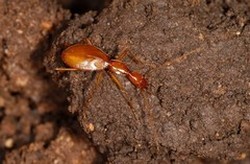about the sep-hcp
Golden-cheeked Warbler

Black-capped Vireo

Rhadine infernalis
Photo by Dr. Jean Krejca
Photo by Dr. Jean Krejca

Highway construction in GCW habitat
issues
Conflicts between endangered species issues and land development in the San Antonio area have intensified, even threatening the future of Camp Bullis in northern Bexar County. Compliance with the Endangered Species Act ("ESA") requires authorization from the U.S. Fish & Wildlife Service ("USFWS") to "take" a listed species, and also requires appropriate mitigation (such as protecting nearby habitat) to offset any adverse impacts to the species. However, the typical process for complying with the ESA can take years and be very costly. Until recently, ESA compliance by the private land development community has been fairly low, with little enforcement of the ESA by the USFWS. With the threat of losing Camp Bullis, endangered species conservation in south central Texas has become a priority and has spurred Bexar County and the City of San Antonio to seek better ways of encouraging ESA compliance and protecting the area's endangered species.
benefits
The SEP-HCP will enhance conservation efforts for the area's endangered and threatened species and facilitate responsible economic growth in south central Texas by reducing the time and uncertainty involved with ESA compliance.
The SEP-HCP will promote the recovery of the area's endangered and threatened species by creating a regional preserve system for the GCW, BCV, and karst invertebrates and providing for the perpetual management and monitoring of these preserve lands for the benefit of the species.
The SEP-HCP will result in a locally created solution to endangered species issues that incorporates stakeholder concerns and gives long-term ESA permitting assurances to the public and private-sector participants. The sep-hcp will create a new, voluntary, streamlined process for ESA compliance that may be used for a variety of public and private projects. This new compliance option will reduce the time associated with obtaining incidental take authorization under the ESA, particularly with respect to developing individual HCPs, waiting for applications to be processed by the USFWS, and obtaining appropriate mitigation for project impacts.
The SEP-HCP's long-term focus over a regional scale will take better advantage of conservation opportunities in a rapidly changing landscape than smaller, individual conservation efforts. The effort's long-term protection and management of natural resources on across multiple counties will also contribute to the general health of the region's Hill Country ecosystems, including wildlife, woodlands, and water.
rare species
South central Texas is rich with a wide variety of natural resources that help define the region's unique character, such as dramatic vistas, endemic wildlife, deep caves, productive aquifers, and flowing waters. Some of these resources are also locally, regionally, or globally rare and sensitive to the effects of human activities. Endangered or threatened wildlife are often particularly sensitive to our use of the landscape. Among these species in south central Texas are the:
- Golden-cheeked Warbler (Dendroica chrysoparia, the "GCW")
- An endangered migratory songbird that nests in mature, dense juniper-oak woodland. This bird is primarily
threatened with the loss or degradation of its habitat by a variety of land development activities. Read more by the Texas Parks & Wildlife Department ("TPWD")
about the biology, life history, habitats, and threats to the GCW.
- Black-capped Vireo (Vireo atricapillus, the "BCV")
- A threatened migratory songbird that nests in open oak shrublands. This species is threatened by several factors
including habitat conversion, overgrazing , and brood parasitism. Read more by the TPWD about the biology, life history, habitats,
and threats to the BCV.
- Rhadine exilis
- An unnamed karst-dwelling beetle that is currently known from 45 to 50 caves in Bexar County.
- Rhadine infernalis
- An unnamed karst-dwelling beetle that is currently known from 36 to 39 caves in Bexar County.
- Helotes Mold Beetle (Batrisodes venyivi)
- A karst-dwelling beetle that is currently known from known from eight caves in Bexar County.
- Cokendolpher Cave Harvestman (Texella cokendolpheri)
- A karst-dwelling harvestman that is currently known only from one cave in Bexar County.
- Government Canyon Bat Cave Spider (Neoleptoneta microps)
- A karst-dwelling spider that is currently known from only two caves in Government Canyon State Natural Area.
- Robber Baron Cave Meshweaver (Cicurina baronia)
- A karst-dwelling spider that is currently known only from one cave in Bexar County.
- Madla Cave Meshweaver (Cicurina madla)
- A karst-dwelling spider that is currently known from several locations in Bexar County.
- Bracken Cave Meshweaver (Cicurina venii)
- A karst-dwelling spider that is currently known only by a single specimen from one locality in Bexar County.
- Government Canyon Bat Cave Meshweaver (Cicurina vespera)
- A karst-dwelling spider that is currently known only from one cave in Bexar County.
The karst invertebrates listed above each live entirely underground in the limestone caves and passages of the karst geologic formations that underlie much of south central Texas. These species are threatened by habitat loss associated with filling or collapsing of caves, alternation of natural drainage patterns and surface plant and animal communities, contamination of groundwater, and quarry or mining operations.
More information on these species is available from NatureServe.





